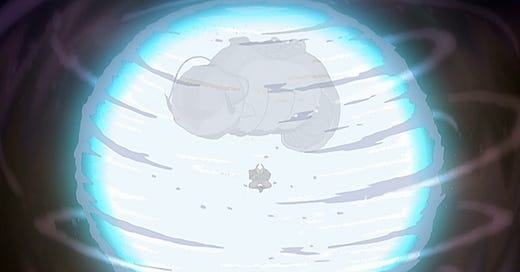Water. Earth. Fire. Air. The four words that started a legend.
Thanks for tuning in to my first of 61 daily reviews of Avatar: The Last Airbender!
In this episode’s extended title sequence, we learn the premise of Avatar. There are four elemental nations: the Water Tribe, the Earth Kingdom, the Fire Nation, and the Air Nomads. Each tribe has “benders” with the power to manipulate one element at will. The Avatar, a reincarnating demigod who can master all four elements, used to keep peace between the nations. But one hundred years ago, the Fire Nation waged war against the other tribes, and the Avatar vanished.
The sequence is narrated by Katara, a hopeful fourteen-year-old girl whose father has left to fight in the war. Our story opens with Katara practicing her waterbending on a canoe while her preening older brother Sokka attempts to fish and sneers at her bending. After an argument sends them floating adrift, they discover a large iceberg with a boy frozen inside.
This mysterious boy, of course, is Aang, a friendly, bald and tattooed twelve-year-old airbender who appears to have been frozen for… one hundred years (see where this is going?). He’s joined by his massive, furry white sky bison, Appa. Returning to their tiny Water Tribe village in the South Pole, Aang shocks the villagers, who claim that nobody has seen an Air Nomad in a hundred years.
In parallel with Aang’s story, we meet the hotheaded Fire Nation prince Zuko and his uncle, General Iroh. Zuko has sailed the world for three years in a quest to resurface the Avatar. He’s single-minded in his pursuit, which is personal for him — his honor hinges on his success.
This episode is weighed down by the amount of background it needs to cover, giving way to a lot more exposition than action. However, it’s a successful first step at building an immersive world brimming with magic, wonder, and culture. Nearly twenty years and one remaster later, the hand-drawn 2D animation still looks fresh and gorgeous. It’s also worth pointing out the deep and admiring inspiration that Avatar pulls from a number of Asian cultures, especially in the design of the four nations and their homes, attire, and fighting style. The Water Tribe draws heavily from the Inuit peoples; the Air Nomads resemble Tibetan monks; the Fire Nation loosely represents Imperial Japan; and the not-yet-seen Earth Kingdom takes notes from dynastic China. All that being said, the show takes plenty of creative liberties and doesn’t try to exactly mimic specific cultures.
The episode also introduces us to the cast we’ll come to love. Many of the characters’ personalities shine already, like Sokka’s comically stern and self-serious whining in response to Aang’s happy-go-lucky antics. Zuko’s hotheaded stubbornness finds a foil in his calm uncle Iroh, who sips tea and advises him to rest. Katara’s idiosyncrasies are less conspicuous, but she lets loose at Sokka with an indignant, righteous tirade, and we learn that she’s motivated by her dream of finding a bending teacher. Meanwhile, Aang appears clueless. “What war?”
The episode ends with Aang and Katara venturing onto a forbidden Fire Nation shipwreck, triggering a booby trap that launches a flare high into the sky. They successfully make their escape while Zuko watches with a spyglass, tracking them back to the village and setting up a conflict for the next episode. Can the villagers of the Southern Water Tribe defend themselves against Zuko and the vicious and powerful Fire Nation?
See you tomorrow for Episode 2: The Avatar Returns! Share your own thoughts on this episode in the comments.
Spare observations
Aang knows more than he lets on. When Sakura asks him if he knew the Avatar, he looks away cagily. In a flashback, we see him riding Appa over the sea. Caught in a brutal storm, they plunge into the water. Aang’s tattoos begin to glow white, and a giant sphere of ice envelops them both.
The war against the Fire Nation has taken its toll. Katara is the only waterbender left in her village. That’s why she’s so desperate for training and hopes to learn from Aang, even though he’s an airbender.
Sokka is the oldest boy in the village, since all the men are off to war. Sokka appears very protective over this responsibility, and his solemn affect (like hilariously referring to his band of rugrats as “warriors”) belies real insecurity over his worthiness to protect his tribe. That and his sarcasm makes him a reliable source of comic relief, from deadpan to slapstick.
But his ice watchtower was actually pretty impressive!
I'll end each review with the "Friends of the White Lotus" section, which is targeted specifically at folks who have already watched the entire series through. If you want to avoid spoilers, stop reading here! Friends of the White Lotus [SPOILERS]
Katara is the first thing Aang sees when he awakens, and he falls for her instantly.
Aang lies to Katara instead of revealing that he’s the Avatar. Later, he will explain that he lied because “he never wanted to be.”
The penguins in this episode are one of the few examples of real animals that appear in Avatar. Perhaps they hadn’t developed their signature hybrids yet.
Correction: Apparently, they are technically “otter penguins,” although I don’t really see where the otter part comes from.





good stuff!! excited for the netflix adaptation and will be following this recap